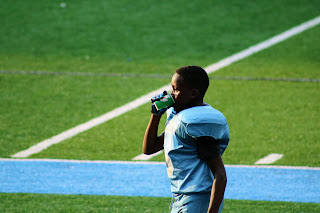I reluctantly checked out Drawing with Children by Mona Brookes from the library. I've experimented enough with sketching to be confident that what's holding me back isn't a particular skill or bit of wisdom, but the commitment to practice, practice, practice. At least, that's what I assumed. Still, I have a firm policy when visiting the library: if a book sparks even the slightest interest, I check it out.
When it comes to learning to draw, I'm a fan of Danny Gregory's approach. I'm oversimplifying here, but it essentially works like this: learn a few basic concepts and then practice daily. Eventually, you'll start creating drawings you're proud of.
As I perused Brookes' Drawing with Children I realized that her method falls on the other end of the structured-learning spectrum. She covers topics from creating an art-friendly environment, to specific language students can use to analyze subjects. She provides exercises and specific works to draw that maximize a learner's chance of success.
Some may chafe under this regimented approach, but I've grown to see it as something quite positive. Through carefully planning Brookes has flattened the learning curve of drawing. If, for example, I had the opportunity to teach my niece to draw I'd almost certainly use Brookes' approach.
But the impact of Drawing with Children on me didn't stop there. It provided me with nothing short of a sketching epiphany. On page 114, in classic Brookes style, she spells out a 20 step algorithm for creating a drawing. This starts with warm-ups and ends with finishing touches. In her recipe she instructs students to start with a central point and build out from there. You see this approach in the sample drawings in the book. For example, one still life starts by drawing the knob which sits on top of the tea pot, which is one of the primary objects in the scene.
I realized this is exactly the opposite strategy I've been using for drawing. I've been attempting to draw the bounds of the scene and fill in detail from there.
Consider these objects:

I'd normally attacking this drawing like so:



The problem with this strategy is that I need to maintain a mental map as to how the contour lines I've drawn correspond to the scene. Compare that to Brookes' method, which focuses on drawing the focal point and building out from there:



I had assumed my frustration with drawing was lack of practice and general anxiety about failing. Instead, I realized I'm just trying to hold too many complex ideas in my head at one time. Using Brookes' approach, I was able to finish the sketch with relative ease:

The contour-approach I started above clearly has value. I think the proportion between the phone, medicine bottle and Lego-character is more accurate than my second attempt. But what good is accurate proportion if the process is mentally exhausting?
Perhaps I'll graduate away from Brooke's approach, but for now I'm telling you, this is a game changer.
















































